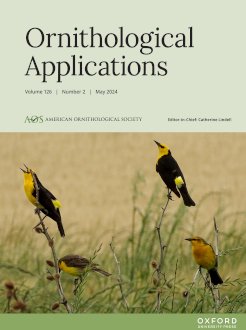Upland Sandpipers (Bartramia longicauda) are a grassland obligate shorebird that nests in dense vegetation structure near recently disturbed areas and could benefit from management practices that promote heterogenous vegetation structure. Upland Sandpipers primary breeding range is generally managed for livestock production using traditional practices that lack patchy disturbances to facilitate higher levels of structural heterogeneity. Patch-burn grazing (PBG) could be an alternative management practice for Upland Sandpiper conservation for its use to create areas of dense vegetation structure near recently disturbed areas. However, limited information is available regarding nest production of Upland Sandpipers within a PBG framework. To assess the compatibility of PBG with Upland Sandpiper conservation, we estimated nest site selection and survival of Upland Sandpiper nests on private lands managed with PBG in the unglaciated plains region of North Dakota. We located 59 nests from 2017 to 2020. Upland Sandpipers avoided 1 year since fire (YSF) patches and selected for 2 and 3 YSF patches for nest sites. Additionally, nest site selection decreased with increased bare ground and at intermediate distances to the nearest Upland Sandpiper nest. Upland Sandpipers experienced high overall nest survival during the study with 51 of 59 nests successfully hatching, which limited our ability to make inferences between daily survival rates and variables of interest. Our findings suggest that PBG can provide suitable nesting cover for Upland Sandpipers in later YSF patches despite annual prescribed fire and livestock grazing during the nesting season. PBG seems a suitable grassland management strategy that should be included in conservation planning within Upland Sandpiper's breeding distribution.
LAY SUMMARY
The Upland Sandpiper is a grassland obligate shorebird of conservation priority that nests in dense vegetation structure near recently disturbed areas.
The Upland Sandpiper's primary breeding range is generally managed with traditional grazing practices, which lacks patchy disturbances that facilitate preferred nesting vegetation.
Patch-burn grazing (PBG) creates areas of dense vegetation structure near recently disturbed areas and could be an alternative management practice for Upland Sandpiper conservation.
We assessed Upland Sandpiper nest site selection and survival on private lands managed with PBG in North Dakota.
Upland Sandpipers selected nesting areas where relatively more time had passed since being burned, avoided areas of bare ground, and avoided intermediate distances to the nearest Upland Sandpiper nest.
Upland Sandpipers experienced high overall nest survival during the study.
PBG can provide suitable nesting cover for Upland Sandpipers.
We recommend PBG as an alternative management strategy for areas used by nesting Upland Sandpipers.
Bartramia longicauda es un ave playera obligada de pastizales que anida en estructuras de vegetación densa cerca de áreas recientemente perturbadas, y podría beneficiarse de prácticas de manejo que fomenten una estructura de vegetación heterogénea. El rango de cría principal de B. longicauda es manejado generalmente para la producción ganadera mediante prácticas tradicionales que carecen de perturbaciones en parches que faciliten niveles más altos de heterogeneidad estructural. El pastoreo en parches quemados (PPQ) podría ser una práctica de manejo alternativa para la conservación de B. longicauda debido a su uso para crear áreas de estructura de vegetación densa cerca de áreas recientemente disturbadas. Sin embargo, poca información está disponible sobre la producción de nidos de B. longicauda dentro de un marco de PPQ. Para evaluar la compatibilidad de PPQ con la conservación de B. longicauda, estimamos la selección de sitios de anidación y la supervivencia de los nidos de B. longicauda en tierras privadas gestionadas con PPQ en la región de las llanuras no glaciares de Dakota del Norte. Localizamos 59 nidos desde 2017 hasta 2020. B. longicauda evitó los parches de 1 año desde el fuego (ADF) y seleccionó los parches de 2 y 3 ADF como sitios de anidación. Además, la selección de sitios de anidación disminuyó con el aumento de suelo desnudo y a distancias intermedias al nido más cercano de B. longicauda. B. longicauda experimentó una alta supervivencia general de nidos durante el estudio, con 51 de 59 nidos que eclosionaron con éxito, lo que limitó nuestra capacidad para hacer inferencias entre las tasas diarias de supervivencia y las variables de interés. Nuestros hallazgos sugieren que el PPQ puede proporcionar una cobertura de anidación adecuada para B. longicauda en parches con más ADF a pesar del fuego prescrito anual y del pastoreo de ganado durante la temporada de anidación. El PPQ parece una estrategia de manejo de pastizales adecuada que debería incluirse en la planificación de conservación dentro de la distribución reproductiva de B. longicauda.






